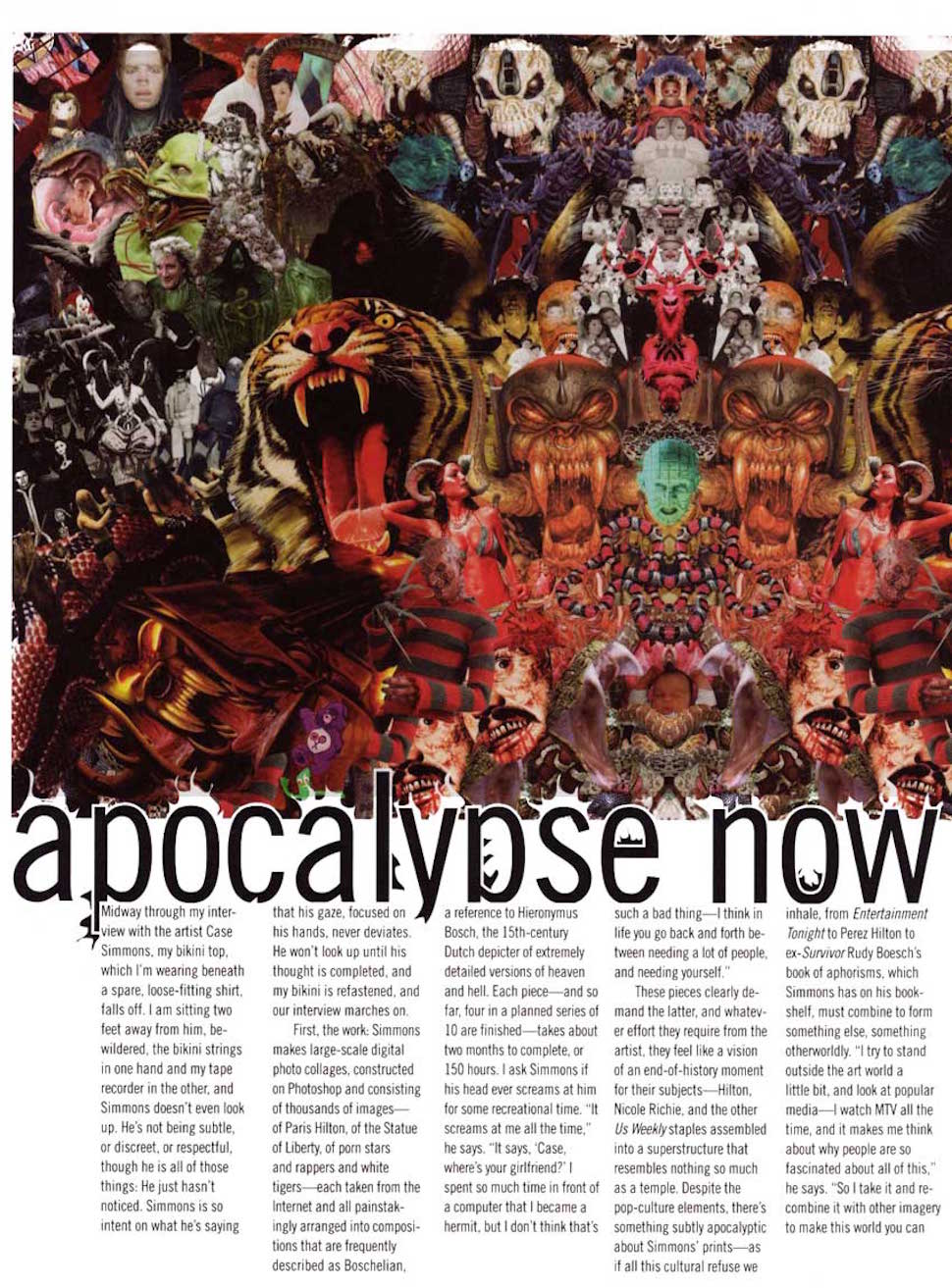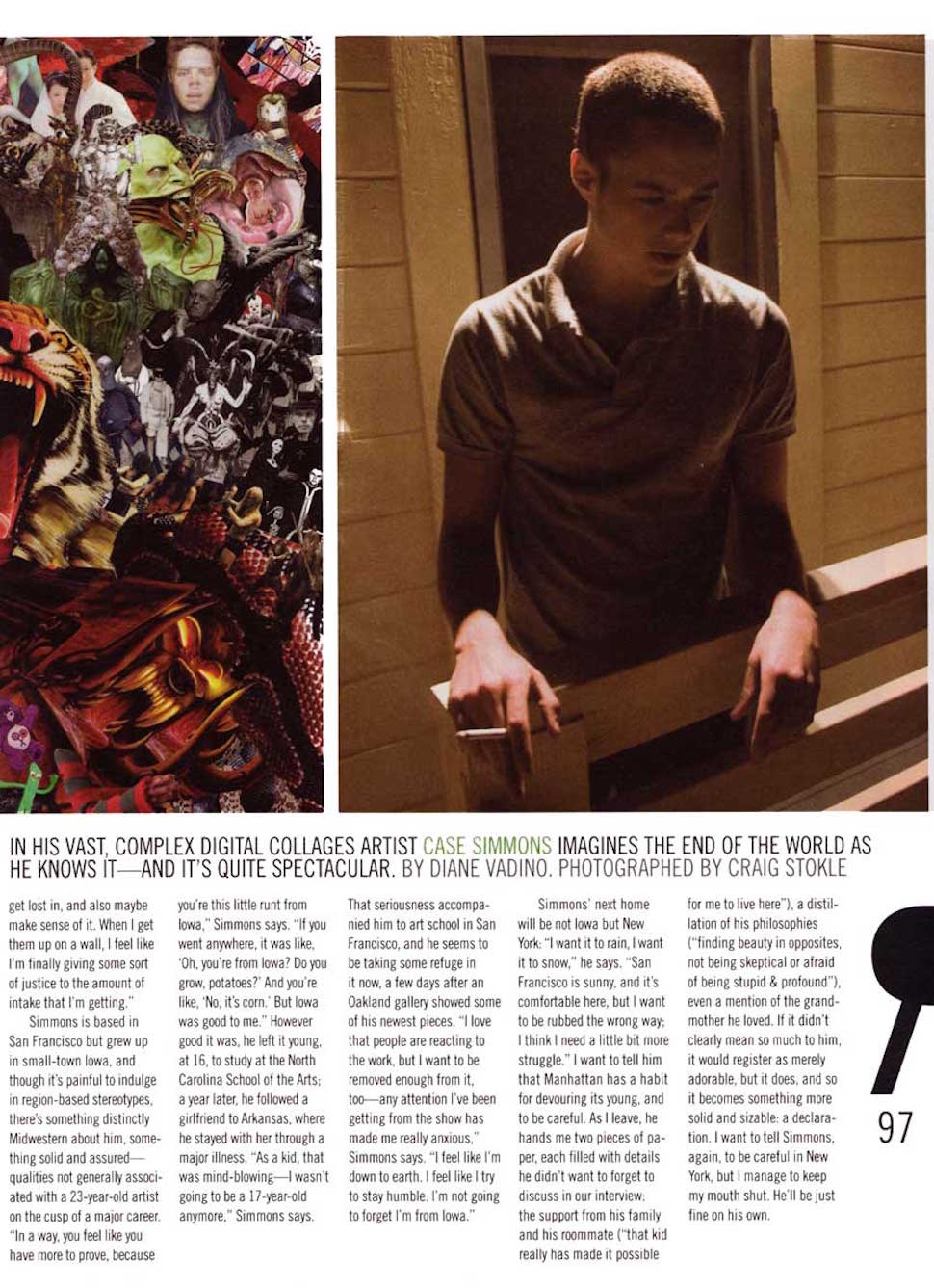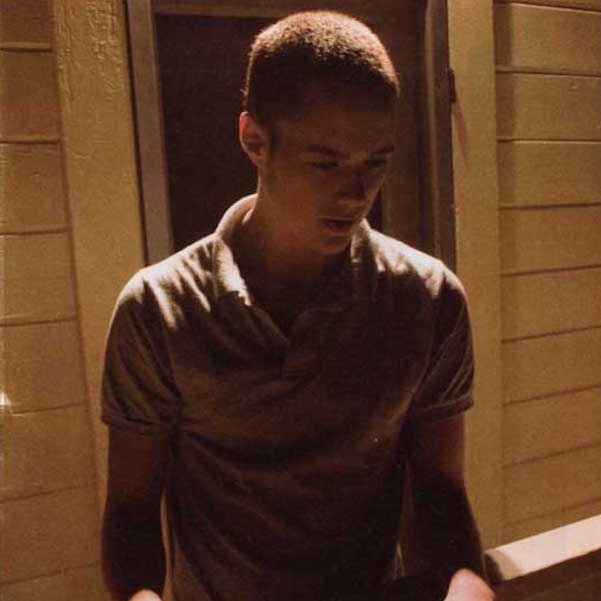

Case Simmons for NYLON Guys: Midway through my interview with the artist Case Simmons, my bikini top, which I’m wearing beneath a spare, loose-fitting shirt, falls off. I am sitting two feet away from him, bewildered, the bikini strings in one hand and my tape recorder in the other, and Simmons doesn’t even look up. He’s not being subtle, or discreet, or respectful, though he is all of those things: He just hasn’t noticed. He’s so intent on what he’s saying that his gaze, focused on his hands, never deviates. He won’t look up until his thought is completed, and my bikini’s refastened, and our interview marches on.
First, the work: Simmons make large-scale digital photo collages, constructed on Photoshop and consisting of thousands of images of Paris Hilton, of the Statue of Liberty, of porn stars and rappers and white tigers, each taken from the Internet and then painstakingly arranged into compositions that are frequently described as Boschelian, a reference to Hieronymus Bosch, the 15th-century Dutch depicter of extremely detailed versions of heaven and hell. Each piece—and so far, four in a planned series of ten are finished—takes about two months to complete, or 150 hours. I ask Simmons at what point his head screams at him for some recreational time. “It screams at me all the time,” he says. “It says, ‘Case, where’s your girlfriend?’ I spent so much time in front of a computer that I became a hermit, but I don’t think that’s such a bad thing—I think in life you go back and forth between needing a lot of people, and needing yourself.”
These pieces clearly demand the latter, and whatever effort they demand from the artist, they feel like a vision of an end-of-history moment for their subjects±Hilton, Nicole Richie, and the other Us Weekly staples assembled into a superstructure that resembles nothing so much as a temple. Despite the pop-culture elements, there’s something subtly apocalyptic about Simmons’ prints—as if all this cultural refuse we inhale, from Entertainment Tonight to Perez Hilton to ex-Survivor Rudy Boesch’s book of aphorisms, which Simmons has on his bookshelf, must combine to form something else, something distinctly otherworldly. “I try to stand outside the art world a little bit, and look at popular media—I watch MTV all the time, and it makes me think about why people are so fascinated about all of this,” he says. “So I take it and recombine it with other imagery to make this world you can get lost in, and also maybe make sense of it. When I get them up on a wall, I feel like I’m finally giving some sort of justice to the amount of intake that I’m getting.”
Simmons is based in San Francisco but grew up in small-town Iowa, and though it’s painful to indulge in region-based stereotypes, there’s something distinctly Midwestern about him, something solid and assured—qualities not generally associated with a 23-year-old artist on the cusp on a major career. “In a way, you feel like you have more to prove, because you’re this little runt from Iowa,” Simmons says. “If you went anywhere, it was like, ‘Oh, you’re from Iowa? What do you grow, potatoes?’ And you’re like, ‘No, it’s corn.’ But Iowa was good to me.” However good it was, he left it young, at 16, to study at the North Carolina School of the Arts; a year later, he followed a girlfriend to Arkansas, where he stayed with her through a major illness. “As a kid, that was mind-blowing—I wasn’t going to be a 17-year-old anymore,” Simmons says. That seriousness accompanied him to art school in San Francisco, and he seems to be taking some refuge in it now, a few days after an Oakland gallery showed some of his newest pieces. “I love that people are reacting to the work, but I want to be removed enough from it, too?any attention I’ve been getting from the show has made me really anxious,” Simmons says. “I feel like I’m down to earth. I feel like I try to stay humble. I’m not going to forget I’m from Iowa.”
Simmons’ next home will be not Iowa but New York: “I want it to rain, I want it to snow,” he says. “San Francisco’s sunny, and it’s comfortable here, but I want to be rubbed the wrong way; I think I need a little big more struggle.” I want to tell him that Manhattan has a habit for devouring its young, and to be careful. As I leave, he hands me two pieces of paper, each filled with details he didn’t want to forget to discuss in our interview: the support from his family and his roommate Calvin (“that kid really has made it possible for me to live here”), a distillation of his philosophies (“finding beauty in opposites, not being skeptical or afraid of being stupid & profound”), even mention of the grandmother he loved. If it didn’t clearly mean so much to him, it’d register as adorable, but it does, and so it becomes something more solid and sizable: a bulwark, against becoming a different person, maybe. I want to tell him, again, to be careful in New York, but I manage to keep my mouth shut: He’ll be just fine on his own.
